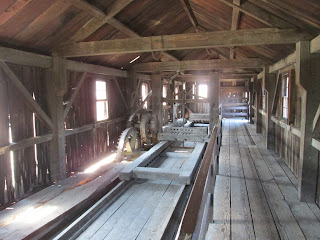Henry Ford said, "I am collecting the history of our people as written into things their
hands made and used.... When we are through, we shall have reproduced
American life as lived, and that, I think, is the best way of preserving
at least a part of our history and tradition."
With that statement, Henry Ford set aside a tract of land in nearby Dearborn to house a large indoor and outdoor history museum complex. But, it's not your normal museum. It's a working museum where you can see an actual farm in action, see and hear the sounds and activities of what it was like in the early 1900s. Most of the docents wear period clothing and will show you how these early machines worked. From clothing looms, sawmills, print shops and glass blowing, you can experience it all. Touring the Village is like stepping into a time machine. You can wander the grounds at your leisure or take a Steam Engine tour. If trains are not to your liking, you can tour the grounds in a genuine Model T or Model A. We chose to do the walking tour through the village. They have the courthouse where Abe Lincoln practiced law, Henry Ford's boyhood home, Noah Websters home and more.
Remember this is a working museum. As such they had corn fields, barns, implements etc. It was designed as a working farm in the early 1900s. Pretty cool.
Water wheels supplied energy for many operations.
The docent here was awesome explaining how these looms worked to supply table cloths, clothing, flags and other articles of cloth.
Seeing these lumber mills up close makes one appreciate just how far we've come in the past 100 years. As primitive as these machines were, they were surprising efficient.
This gentleman explained just how a printing press worked, then "borrowed" one of the observers and actually made a flyer from scratch.
We visited the train station too. One of the highlights of this area is the roundhouse. They pull an engine with a coal car onto the roundhouse then manually turn it around and off on another track. The roundhouse has to be perfectly balanced in order to be able to do that.
Tours can be taken by steam engine or Model T's as seen here. Unfortunately, these tours are guided tours, so you're just a passenger.
If you prefer a Model A, then this is your baby. Notice the wide streets and very little crowds. We picked a perfect day to tour the facility.
We visited the Martha-Mary chapel. A 19th Century chapel featuring a pipe organ and candle lit chandeliers, it opens onto the Village Green--below.
The Village Green. They had many games set up for the kids. We played baseball with a stick and a leather ball, tried some stilts and played a game with woven leather circles.
One of the early schoolhouses, preserved as it would have been around the turn of the century.
We owe the fantasy of flight to the Wright Brothers. This is a portion of their bicycle shop where they perfected their vision of flight.
On display, was an actual verified piece of the Wright Brothers aircraft.
Let's take a look at Henry Ford's home. He was an innovator and a tinkerer. He always felt anything was possible if you simply tried it.
Don't want to walk the grounds? Take this 19th Century steam locomotive that circles the entire complex.
Don't forget to also visit the Henry Ford Museum adjacent to the Village. Across the street is the Ford Rotunda and test track, where prototypes are tested before being placed into production.




















No comments:
Post a Comment